i
i
1
i
i
GPOPS − II: A MATLAB Software for Solving Multiple-Phase Optimal
Control Problems Using hp-Adaptive Gaussian Quadrature
Collocation Methods and Sparse Nonlinear Programming
MICHAEL A. PATTERSON and ANIL V. RAO, University of Florida
A general-purpose MATLAB software program called GPOPS − II is described for solving multiple-phase
optimal control problems using variable-order Gaussian quadrature collocation methods. The software em-
ploys a Legendre-Gauss-Radau quadrature orthogonal collocation method where the continuous-time opti-
mal control problem is transcribed to a large sparse nonlinear programming problem (NLP). An adaptive
mesh refinement method is implemented that determines the number of mesh intervals and the degree of
the approximating polynomial within each mesh interval to achieve a specified accuracy. The software can
be interfaced with either quasi-Newton (first derivative) or Newton (second derivative) NLP solvers, and
all derivatives required by the NLP solver are approximated using sparse finite-differencing of the optimal
control problem functions. The key components of the software are described in detail and the utility of the
software is demonstrated on five optimal control problems of varying complexity. The software described in
this article provides researchers a useful platform upon which to solve a wide variety of complex constrained
optimal control problems.
Categories and Subject Descriptors: G.1.4 [Numerical Analysis]: Quadrature and Numerical
Differentiation
General Terms: Algorithms, Design, Verification
Additional Key Words and Phrases: Optimal control, direct collocation, Gaussian quadrature, hp–adaptive
methods, numerical methods, MATLAB, scientific computation, applied mathematics
ACM Reference Format:
Patterson, M. A. and Rao, A. V. 2012. GPOPS-II: A MATLAB software for solving multiple-phase optimal
control problems using hp–adaptive Gaussian quadrature collocation methods and sparse nonlinear pro-
gramming. ACM Trans. Math. Softw. 41, 1, Article 1 (October 2014), 37 pages.
DOI:http://dx.doi.org/10.1145/2558904
1. INTRODUCTION
Optimal control problems arise in a wide variety of subjects including virtually all
branches of engineering, economics, and medicine. Because optimal control applica-
tions have increased in complexity in recent years, over the past two decades the
subject of optimal control has transitioned from theory to computation. In particular,
computational optimal control has become a science in and of itself, resulting in a vari-
ety of numerical methods and corresponding software implementations of these meth-
ods. The vast majority of software implementations of optimal control today are those
that involve the direct transcription of a continuous-time optimal control problem
The authors gratefully acknowledge partial support for this research from the U.S. Office of Naval Research
(ONR) under Grant N00014-11-1-0068 and from the U.S. Defense Advanced Research Projects Agency
(DARPA) Under Contract HR0011-12-C-0011. The views expressed are those of the authors and do not
reflect the official policy or position of the Department of Defense or the U.S. Government.
Author’s addresses: M. A. Patterson and A. V. Rao, Department of Mechanical and Aerospace Engineering,
P.O. Box 116250, University of Florida, Gainesville, FL 32611-6250; e-mail: {mpatterson,anilvrao}@ufl.edu.
Permission to make digital or hard copies of all or part of this work for personal or classroom use is granted
without fee provided that copies are not made or distributed for profit or commercial advantage and that
copies bear this notice and the full citation on the first page. Copyrights for components of this work owned
by others than ACM must be honored. Abstracting with credit is permitted. To copy otherwise, or repub-
lish, to post on servers or to redistribute to lists, requires prior specific permission and/or a fee. Request
permissions from permissions@acm.org.
© 2014 ACM 0098-3500/2014/10-ART1 $15.00
DOI:http://dx.doi.org/10.1145/2558904
ACM Transactions on Mathematical Software, Vol. 41, No. 1, Article 1, Publication date: October 2014.
i
i
i
i
�
i
i
i
i
1:2
M. A. Patterson and A. V. Rao
to a nonlinear programming problem (NLP), and the NLP is solved using well-
established techniques. Examples of well-known software for solving optimal control
problems include SOCS [Betts 1998], DIRCOL [von Stryk 2000], GESOP [Jansch et al.
1994], OTIS [Vlases et al. 1990], MISER [Goh and Teo 1988], PSOPT [Becerra 2009],
GPOPS [Rao et al. 2010], ICLOCS [Falugi et al. 2010], JModelica [Åkesson et al. 2010],
ACADO [Houska et al. 2011], and Sparse Optimization Suite (SOS) [Betts 2013].
Over the past two decades, direct collocation methods have become popular in
the numerical solution of nonlinear optimal control problems. In a direct collocation
method, the state and control are discretized at a set of appropriately chosen points
in the time interval of interest. The continuous-time optimal control problem is then
transcribed to a finite-dimensional NLP. The resulting NLP is then solved using well-
known software such as SNOPT [Gill et al. 2002], IPOPT [Wächter and Biegler 2006;
Biegler and Zavala 2008], and KNITRO [Byrd et al. 2006]. Originally, direct collo-
cation methods were developed as h methods (e.g., Euler or Runge-Kutta methods)
where the time interval is divided into a mesh and the state is approximated using
the same fixed-degree polynomial in each mesh interval. Convergence in an h method
is then achieved by increasing the number and placement of the mesh points [Betts
2010; Jain and Tsiotras 2008; Zhao and Tsiotras 2011]. More recently, a great deal
of research as been done in the class of direct Gaussian quadrature orthogonal collo-
cation methods [Benson et al. 2006; Darby et al. 2011a; Elnagar and Razzaghi 1998;
Elnagar et al. 1995; Garg et al. 2010, 2011a, 2011b; Gong et al. 2008b; Huntington
and Rao 2008; Huntington et al. 2007; Kameswaran and Biegler 2008; Patterson and
Rao 2012; Rao et al. 2010]. In a Gaussian quadrature collocation method, the state is
typically approximated using a Lagrange polynomial where the support points of the
Lagrange polynomial are chosen to be points associated with a Gaussian quadrature.
Originally, Gaussian quadrature collocation methods were implemented as p methods
using a single interval. Convergence of the p method was then achieved by increasing
the degree of the polynomial approximation. For problems whose solutions are smooth
and well behaved, a p Gaussian quadrature collocation method has a simple structure
and converges at an exponential rate [Canuto et al. 1988; Fornberg 1998; Trefethen
2000]. The most well-developed p Gaussian quadrature methods are those that employ
either Legendre-Gauss (LG) points [Benson et al. 2006; Rao et al. 2010], Legendre-
Gauss-Radau (LGR) points [Garg et al. 2010, 2011a; Kameswaran and Biegler 2008],
or Legendre-Gauss-Lobatto (LGL) points [Elnagar et al. 1995].
In this article we describe a new optimal control software called GPOPS − II that em-
ploys hp-adaptive Gaussian quadrature collocation methods. An hp-adaptive method
is a hybrid between a p method and an h method in that both the number of mesh
intervals and the degree of the approximating polynomial within each mesh interval
can be varied in order to achieve a specified accuracy in the numerical approxima-
tion of the solution to the continuous-time optimal control problem. As a result, in
an hp-adaptive method, it is possible to take advantage of the exponential conver-
gence of a global Gaussian quadrature method in regions where the solution is smooth
and introduce mesh points only near potential discontinuities or in regions where the
solution changes rapidly. Originally, hp methods were developed as finite-element
methods for solving partial differential equations [Babuska et al. 1986; Babuska and
Rheinboldt 1979, 1981, 1982]. In the past few years, the problem of developing hp
methods for solving optimal control problems has been of interest [Darby et al. 2011b;
2011c]. The work of Darby et al. [2011b, 2011c] provides examples of the benefits of
using an hp-adaptive method over either a p method or an h method. This recent
research has shown that convergence using hp methods can be achieved with a
significantly smaller finite-dimensional approximation than would be required when
using either an h or a p method.
ACM Transactions on Mathematical Software, Vol. 41, No. 1, Article 1, Publication date: October 2014.
i
i
i
i
�
i
i
i
i
GPOPS − II: A MATLAB Software for Solving Multiple-Phase Optimal Control Problems
1:3
It is noted that previously the software GPOPS was published in Rao et al. [2010].
While GPOPS is similar to GPOPS − II in that both software programs implement
Gaussian quadrature collocation, GPOPS − II is a fundamentally different software
program from GPOPS. First, GPOPS employs p (global) collocation in each phase of
the optimal control problem. It is known that p collocation schemes are limited in that
they have difficulty solving problems whose solutions change rapidly in certain re-
gions or are discontinuous. Moreover, p methods become computationally intractable
as the degree of the approximating polynomial becomes very large. GPOPS − II, how-
ever, employs hp-adaptive mesh refinement where the polynomial degree, number of
mesh intervals, and width of each mesh interval can be varied. The hp-adaptive meth-
ods allow for placement of collocation points in regions of the solution where additional
information is needed to capture key features of the optimal solution. Next, GPOPS is
limited in that it can be used with only quasi-Newton (first derivative) NLP solvers and
derivative approximations were performed on high dimensional NLP functions. On the
other hand, GPOPS − II implements sparse derivative approximations by approximat-
ing derivatives of the optimal control functions and inserting these derivatives into the
appropriate locations in the NLP derivative functions. Moreover, GPOPS − II imple-
ments approximations to both first and second derivatives. Consequently, GPOPS − II
utilizes in an efficient manner the full capabilities of a much wider range of NLP
solvers (e.g., full Newton NLP solvers such as IPOPT [Biegler and Zavala 2008] and
KNITRO [Byrd et al. 2006]) and, as a result, is capable of solving a much wider range
of optimal control problems as compared with GPOPS.
The objective of this article is to provide researchers with a novel efficient general-
purpose optimal control software that is capable of solving a wide variety of complex
constrained continuous-time optimal control problems. In particular, the software de-
scribed in this article employs a differential and implicit integral form of the multiple-
interval version of the Legendre-Gauss-Radau (LGR) collocation method [Garg et al.
2010, 2011a, 2011b; Patterson and Rao 2012]. The LGR collocation method is chosen
for use in the software because it provides highly accurate state, control, and costate
approximations while maintaining a relatively low-dimensional approximation of the
continuous-time problem. The key components of the software are then described, and
the software is demonstrated on five examples from the open literature that have been
studied extensively and whose solutions are known. Each of these examples demon-
strates different capabilities of the software. The first example is the hypersensitive
optimal control problem from Rao and Mease [2000] and demonstrates the ability of
the software to accurately solve a problem whose optimal solution changes rapidly in
particular regions of the solution. The second example is the reusable launch vehicle
entry problem taken from Betts [2010] and demonstrates the ability of GPOPS − II to
compute an accurate solution using a relatively coarse mesh. The third example is a
space station attitude control problem taken from Pietz [2003] and Betts [2010] and
demonstrates the ability of the software to generate accurate solutions to a problem
whose solution is not intuitive. The fourth example is a chemical kinetic batch reactor
problem taken from Leineweber [1998] and Betts [2010] and shows the ability of the
software to handle a multiple-phase optimal control problem that is poorly scaled. The
fifth example is a launch vehicle ascent problem taken from Benson [2004], Rao et al.
[2010], and Betts [2010] that again demonstrates the ability of the software to solve
a multiple-phase optimal control problem. In order to validate the results, the solu-
tions obtained using GPOPS − II are compared against the solutions obtained using
the software Sparse Optimization Suite (SOS) [Betts 2013] where SOS is based on the
collection of algorithms developed in Betts [2010].
This article is organized as follows: In Section 2, we describe a general multiple-
phase optimal control problem. In Section 3, we describe the Radau collocation method
ACM Transactions on Mathematical Software, Vol. 41, No. 1, Article 1, Publication date: October 2014.
i
i
i
i
�
i
i
i
i
1:4
M. A. Patterson and A. V. Rao
that is used as the basis of GPOPS − II. In Section 4, we describe the key components of
GPOPS − II. In Section 5, we show the results obtained using the software on the five
aforementioned examples. In Section 6, we provide a discussion of the results obtained
using the software. In Section 7, we discuss possible limitations of the software. Finally,
in Section 8, we provide conclusions on our work.
2. GENERAL MULTIPLE-PHASE OPTIMAL CONTROL PROBLEMS
The general multiple-phase optimal control problem that can be solved by GPOPS − II
is given as follows. First, let p ∈ [ 1, . . . , P] be the phase number where P as the total
number of phases. The optimal control problem is to determine the state, y(p)(t) ∈ Rn(p)
y ,
control, u(p)(t) ∈ Rn(p)
∈ R, phase terminus
∈ R, in all phases p ∈ [ 1, . . . , P], along with the static parameters s ∈ Rns,
times, t(p)
that minimize the objective functional
J = φ
e(1), . . . , e(P), s
u , integrals, q(p) ∈ Rn(p)
q , start times, t(p)
0
,
f
subject to the dynamic constraints
˙y(p) = a(p)(y(p), u(p), t(p), s),
(p = 1, . . . , P),
e(1), . . . , e(P), s
≤ bmax,
the event constraints
bmin ≤ b
the inequality path constraints
≤ c(p)(y(p), u(p), t(p), s) ≤ c(p)
max,
(p = 1, . . . , P),
c(p)
min
the static parameter constraints
smin ≤ s ≤ smax,
and the integral constraints
where
q(p)
min
t(p)
0
y(p)
≤ q(p) ≤ q(p)
max,
t(p)
f
, t(p)
0 , y(p)
e(p) =
(p = 1, . . . , P),
, t(p)
f
, q(p)
, (p = 1, . . . , P),
and the integrals in each phase are defined as
=
q(p)
i
g(p)
i
(y(p), u(p), t(p), s)dt,
(i = 1, . . . n(p)
q ), (p = 1, . . . , P).
t(p)
f
t(p)
0
(1)
(2)
(3)
(4)
(5)
(6)
(7)
(8)
It is important to note that the event constraints of Eq. (3) can contain any functions
that relate information at the start and/or terminus of any phase (including relation-
ships that include both static parameters and integrals) and that the phases them-
selves need not be sequential. It is noted that the approach to linking phases is based
on well-known formulations in the literature such as those given in Betts [1990, 2010].
A schematic of how phases can potentially be linked is given in Figure 1.
ACM Transactions on Mathematical Software, Vol. 41, No. 1, Article 1, Publication date: October 2014.
i
i
i
i
�
i
i
i
i
GPOPS − II: A MATLAB Software for Solving Multiple-Phase Optimal Control Problems
1:5
Fig. 1. Schematic of linkages for multiple-phase optimal control problem. The example shown in the picture
consists of five phases where the ends of phases 1, 2, and 3 are linked to the starts of phases 2, 3, and 4,
respectively, while the end of phase 2 is linked to the start of phase 5.
3. MULTIPLE-INTERVAL RADAU COLLOCATION METHOD
In this section, we describe the multiple-interval Legendre-Gauss-Radau collocation
method (referred to hereafter as the Radau collocation method) [Garg et al. 2010,
2011a, 2011b; Patterson and Rao 2012] that forms the basis for GPOPS − II. In or-
der to make the description of the Radau collocation method as clear as possible, in
this section we consider only a one-phase optimal control problem. After formulating
the one-phase optimal control problem we develop the Radau collocation method itself.
3.1. Single-Phase Optimal Control Problem
In order to describe the hp Radau method that is implemented in the software, it will
be useful to simplify the general optimal control problem given in Eqs. (1)–(8) to a one-
phase problem as follows. Determine the state, y(t) ∈ Rny, the control, u(t) ∈ Rnu, the
integrals, q ∈ Rnq, the initial time, t0, and the terminal time tf on the time interval
t ∈ [ t0, tf ] that minimize the cost functional
J = φ (y(t0), t0, y(tf ), tf , q)
subject to the dynamic constraints
= a(y(t), u(t), t),
dy
dt
the inequality path constraints
the integral constraints
qi =
and the event constraints
t0
cmin ≤ c(y(t), u(t), t) ≤ cmax,
tf
gi(y(t), u(t), t) dt,
(i = 1, . . . , nq),
bmin ≤ b(y(t0), t0, y(tf ), tf , q) ≤ bmin.
(9)
(10)
(11)
(12)
(13)
ACM Transactions on Mathematical Software, Vol. 41, No. 1, Article 1, Publication date: October 2014.
i
i
i
i
�
i
i
i
i
1:6
M. A. Patterson and A. V. Rao
The functions φ, q, a, c and b are defined by the following mappings:
φ : Rny × R × Rny × R × Rnq → R,
q : Rny × Rnu × R
→ Rnq,
a : Rny × Rnu × R
→ Rny,
c : Rny × Rnu × R
→ Rnc,
b : Rny × R × Rny × R × Rnq → Rnb,
where we remind the reader that all vector functions of time are treated as row vectors.
In order to employ the hp Radau collocation method used in GPOPS − II, the con-
tinuous optimal control problem of Eqs. (9)–(13) is modified as follows. First, let
τ ∈ [−1,+1] be a new independent variable. The variable t is then defined in terms of
τ as
t = tf − t0
τ + tf + t0
2
2
.
(14)
The optimal control problem of Eqs. (9)–(13) is then defined in terms of the variable
τ as follows. Determine the state, y(τ ) ∈ Rny, the control u(τ ) ∈ Rnu, the integral
q ∈ Rnq, the initial time, t0, and the terminal time tf on the time interval τ ∈ [−1,+1]
that minimize the cost functional
2
J = φ (y(−1), t0, y(+1), tf , q)
= tf − t0
a(y(τ ), u(τ ), τ; t0, tf ),
dy
dτ
cmin ≤ c(y(τ ), u(τ ), τ; t0, tf ) ≤ cmax,
+1
−1
gi(y(τ ), u(τ ), τ; t0, tf ) dτ,
(i = 1, . . . , nq),
subject to the dynamic constraints
the inequality path constraints
the integral constraints
qi = tf − t0
2
and the event constraints
(15)
(16)
(17)
(18)
(20)
(21)
(22)
bmin ≤ b(y(−1), t0, y(+1), tf , q) ≤ bmin.
(19)
Suppose now that the interval τ ∈ [−1,+1] is divided into a mesh consisting of K
mesh intervals [ Tk−1, Tk] , k = 1, . . . , K, where (T0, . . . , TK ) are the mesh points. The
mesh points have the property that −1 = T0 < T1 < T2 < ··· < TK = Tf = +1.
Next, let y(k)(τ ) and u(k)(τ ) be the state and control in mesh interval k. The optimal
control problem of Eqs. (15)–(19) can then written as follows. First, the cost functional
of Eq. (15) can be written as
J = φ (y(1)(−1), t0, y(K)(+1), tf , q),
Next, the dynamic constraints of Eq. (16) in mesh interval k can be written as
(k = 1, . . . , K).
a(y(k)(τ (k)), u(k)(τ (k)), τ (k); t0, tf ),
= tf − t0
dy(k)(τ (k))
dτ (k)
2
Furthermore, the path constraints of (17) in mesh interval k are given as
(k = 1, . . . , K).
cmin ≤ c(y(k)(τ (k)), u(k)(τ (k)), τ (k); t0, tf ) ≤ cmax,
ACM Transactions on Mathematical Software, Vol. 41, No. 1, Article 1, Publication date: October 2014.
i
i
i
i
�
i
i
i
i
GPOPS − II: A MATLAB Software for Solving Multiple-Phase Optimal Control Problems
1:7
the integral constraints of (18) are given as
qj = tf − t0
2
Tk
Tk−1
K
k=1
gj(y(k)(τ (k)), u(k)(τ (k)), τ (k); t0, tf ) dτ,
(j = 1, . . . , nq, k = 1 . . . , K).
(23)
Finally, the event constraints of Eq. (19) are given as
bmin ≤ b(y(1)(−1), t0, y(K)(+1), tf , q) ≤ bmax.
(24)
Because the state must be continuous at each interior mesh point, it is required
that the condition y(k)(Tk) = y(k+1)(Tk) be satisfied at the interior mesh points
(T1, . . . , TK−1).
3.2. Approximation of the Optimal Control Problem via Radau Collocation Method
The method utilized in the software is an implementation of the aforementioned Radau
quadrature orthogonal collocation method [Garg et al. 2010, 2011a, 2011b; Patterson
and Rao 2012]. In the Radau collocation method, the state of the continuous-time op-
timal control problem is approximated in each mesh interval k ∈ [ 1, . . . , K] as
y(k)(τ ) ≈ Y(k)(τ ) = Nk+1
Y(k)
j (k)
j
(τ ),
(k)
j
j=1
(τ ) = Nk+1
l=1
l=j
τ − τ (k)
− τ (k)
τ (k)
j
l
l
,
(25)
j
where τ ∈ [−1,+1], (k)
(τ ), j = 1, . . . , Nk + 1, is a basis of Lagrange polynomials,
(τ (k)
1 , . . . , τ (k)
) are the Legendre-Gauss-Radau [Abramowitz and Stegun 1965] (LGR)
Nk
collocation points in mesh interval k defined on the subinterval τ (k) ∈ [ Tk−1, Tk), and
= Tk is a noncollocated point. Differentiating Y(k)(τ ) in Eq. (25) with respect to
τ (k)
Nk+1
τ, we obtain
dY(k)(τ )
dτ
= Nk+1
j=1
Y(k)
j
(τ )
d(k)
j
dτ
.
(26)
(27)
The cost functional of Eq. (20) is then shown as
1 , t0, Y(K)
J = φ (Y(1)
NK+1, tf , q),
is the approximation of y(T0 = −1), and Y(K)
where Y(1)
NK+1 is the approximation of
y(TK = +1). Collocating the dynamics of Eq. (21) at the Nk LGR points using Eq. (26),
1
we have
where U(k)
in mesh interval k ∈ [ 1, . . . , K], and t(k)
i
2
i
i
i
a(Y(k)
, U(k)
, τ (k)
D(k)
ij Y(k)
j
− tf − t0
; t0, tf ) = 0,
Nk+1
j=1
, i = 1, . . . , Nk, are the approximations of the control at the Nk LGR points
⎡
⎣d(k)
j
dτ
i are obtained from τ (k)
j = 1, . . . , Nk + 1,
k using Eq. (14) and
(i = 1, . . . , Nk).
(i = 1, . . . , Nk,
k = 1, . . . , K),
⎤
⎦
(28)
(29)
(τ )
,
=
D(k)
ij
(k)
τ
i
ACM Transactions on Mathematical Software, Vol. 41, No. 1, Article 1, Publication date: October 2014.
i
i
i
i
�
i
i
i
i
1:8
M. A. Patterson and A. V. Rao
Fig. 2. Structure of composite Legendre-Gauss-Radau differentiation matrix where the mesh consists of K
mesh intervals.
is the Nk × (Nk + 1) Legendre-Gauss-Radau differentiation matrix [Garg et al. 2010]
in mesh interval k ∈ [ 1, . . . , K]. While the dynamics can be collocated in differential
form, an alternative approach is to collocate the dynamics using the equivalent im-
plicit integral form of the Radau collocation method as described in Garg et al. [2010,
2011a, 2011b]. Collocating the dynamics using the implicit integral form of the Radau
collocation method, we have
Nk
j=1
(i = 1, . . . , Nk),
; t0, tf ) = 0,
− tf − t0
I(k)
ij a(Y(k)
i
, U(k)
, τ (k)
− Y(k)
1
Y(k)
i+1
(30)
2
i
i
−1
I(k) ≡
, (i = 1, . . . , Nk, j = 1, . . . , Nk, k = 1, . . . , K) is the Nk × Nk Legendre-Gauss-
where I(k)
Radau integration matrix in mesh interval k ∈ [ 1, . . . , K], and is obtained from the
ij
differentiation matrix as Garg et al. [2010, 2011a, 2011b]
D(k)
2:Nk+1
= −1, where 1 is a column vector of
Finally, it is noted for completeness that I(k)D(k)
1
length Nk of all ones. It is noted that Eqs. (28) and (30) can be be evaluated over all
intervals simultaneously using the composite Legendre-Gauss-Radau differentiation
matrix D, and the composite Legendre-Gauss-Radau integration matrix I, respectively.
Furthermore, the sparse structure of the composite Legendre-Gauss-Radau differenti-
ation matrix D can be seen in Figure 2, and the structure of the composite Legendre-
Gauss-Radau integration matrix I can be seen in Figure 3. Next, the path constraints
of Eq. (22) in mesh interval k ∈ [ 1, . . . , K] are enforced at the Nk LGR points as
.
cmin ≤ c(Y(k)
i
, U(k)
i
, τ (k)
i
; t0, tf ) ≤ cmax,
(i = 1, . . . , Nk),
(31)
the integral constraints of Eq. (23) is then approximated as
qj ≈ K
k=1
Nk
i=1
tf − t0
2
i gj(Y(k)
w(k)
i
, U(k)
i
, τ (k)
i
; t0, tf ),
(i = 1, . . . , Nk, j = 1, . . . , nq),
(32)
ACM Transactions on Mathematical Software, Vol. 41, No. 1, Article 1, Publication date: October 2014.
i
i
i
i
�
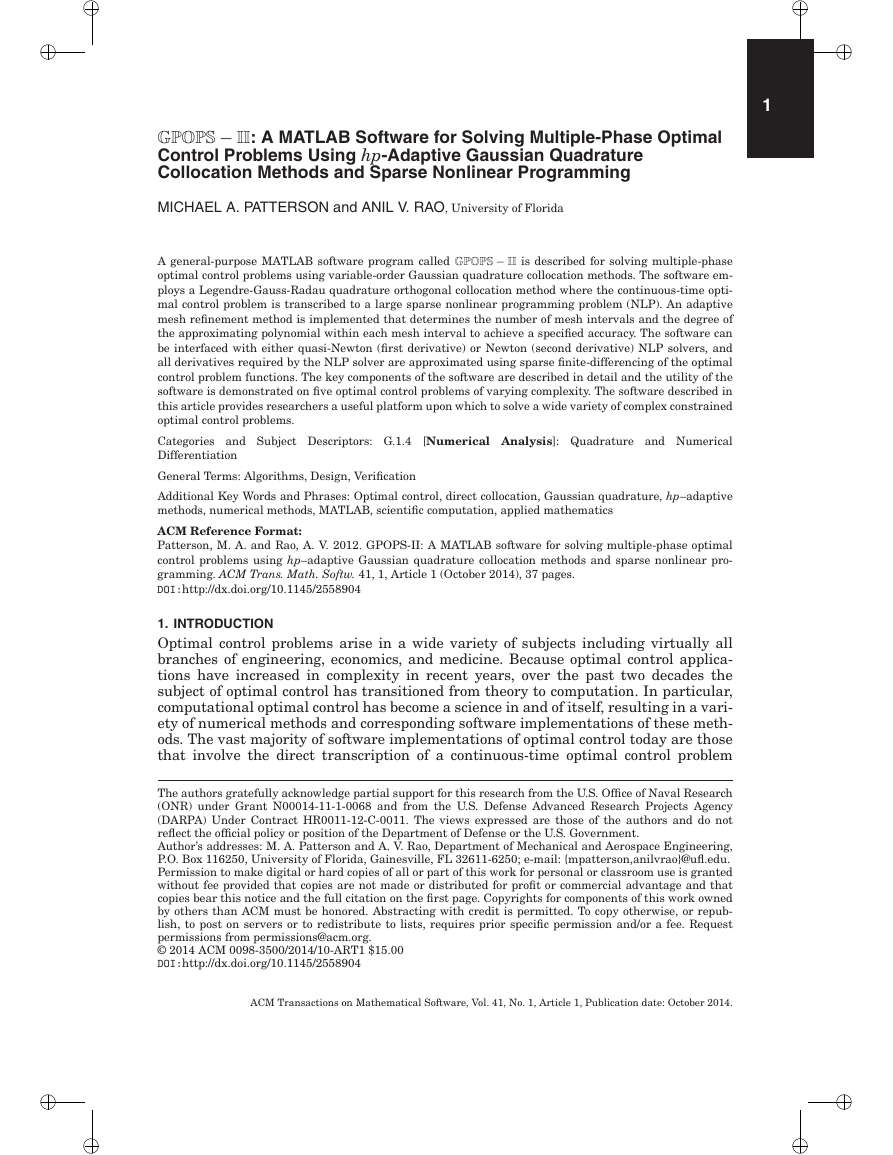
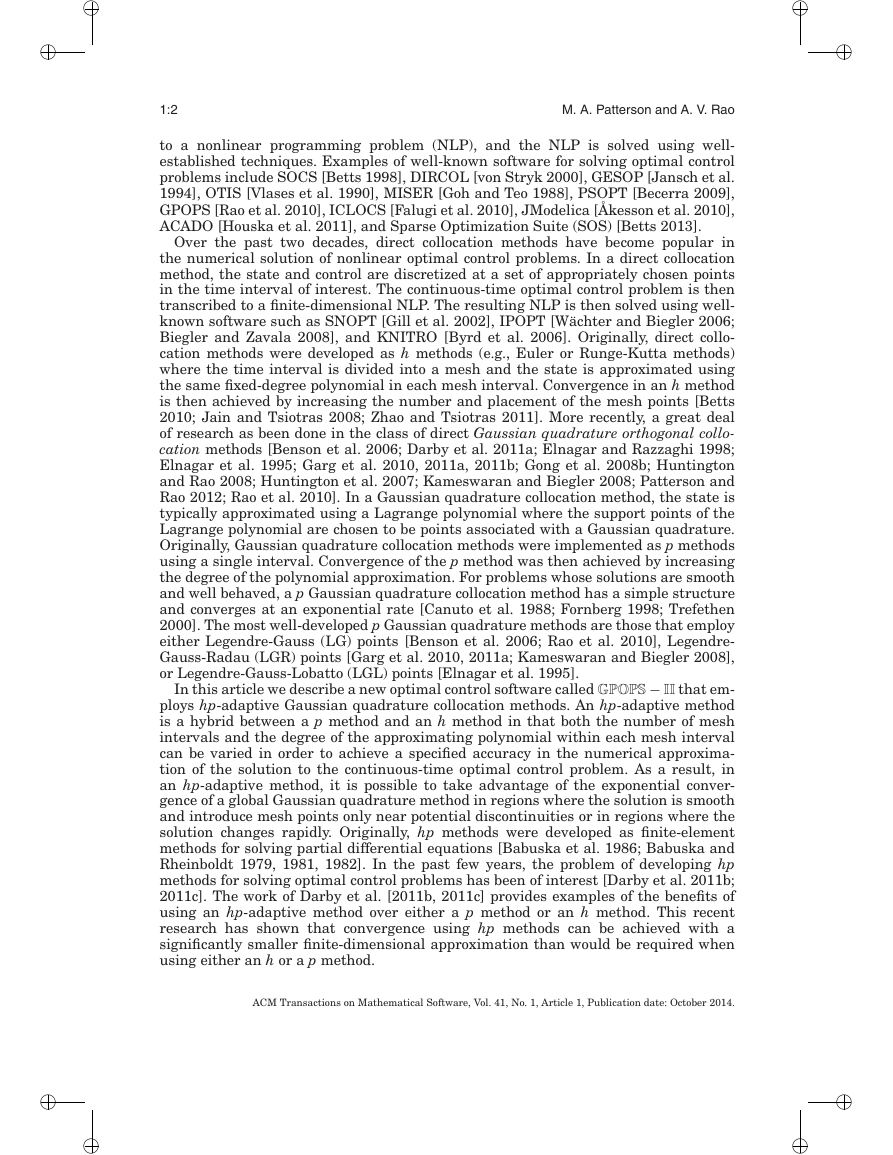
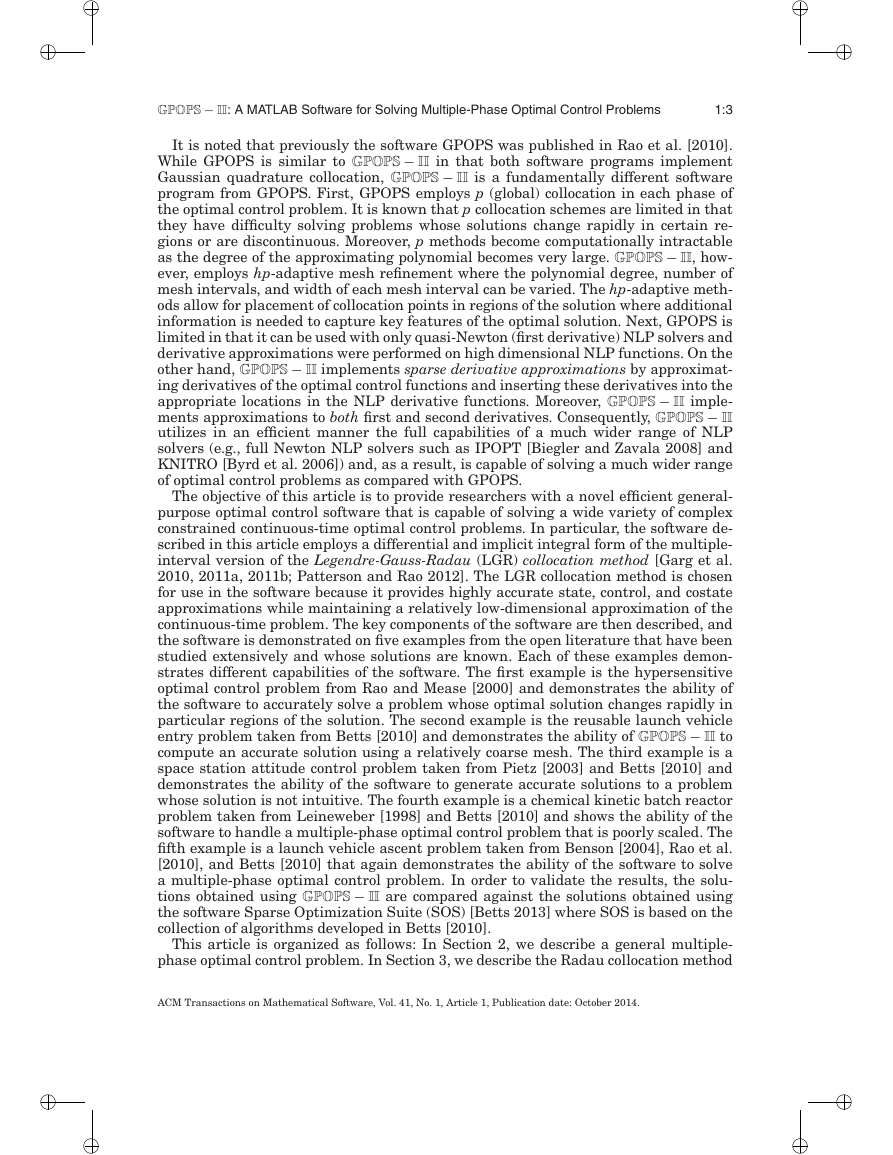
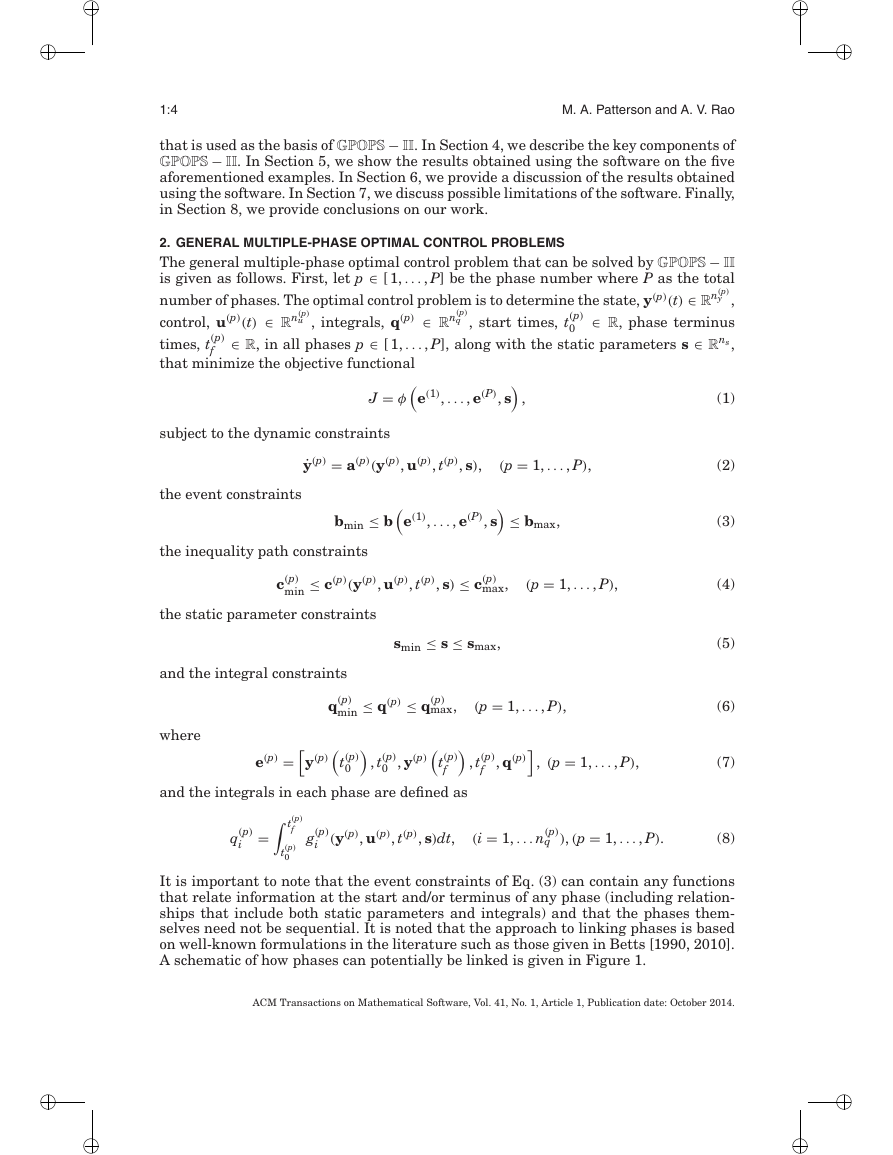
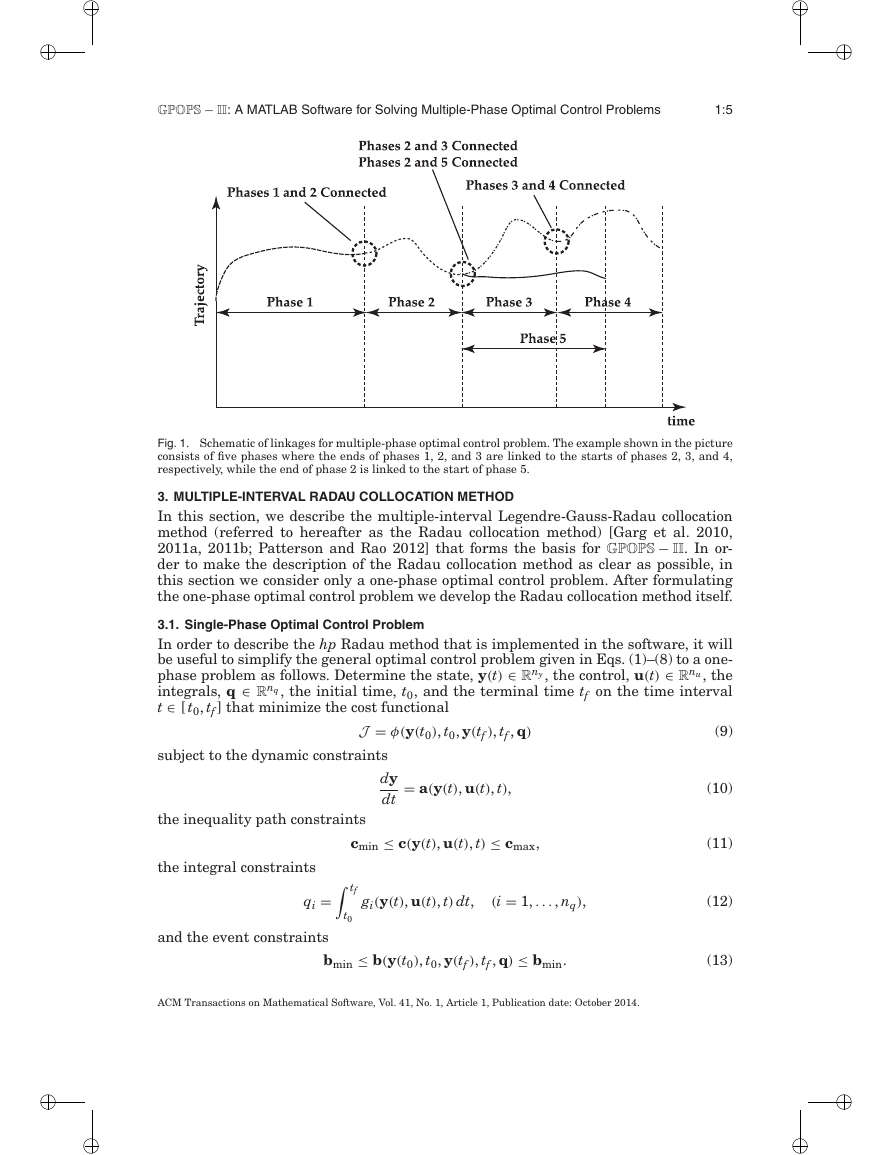

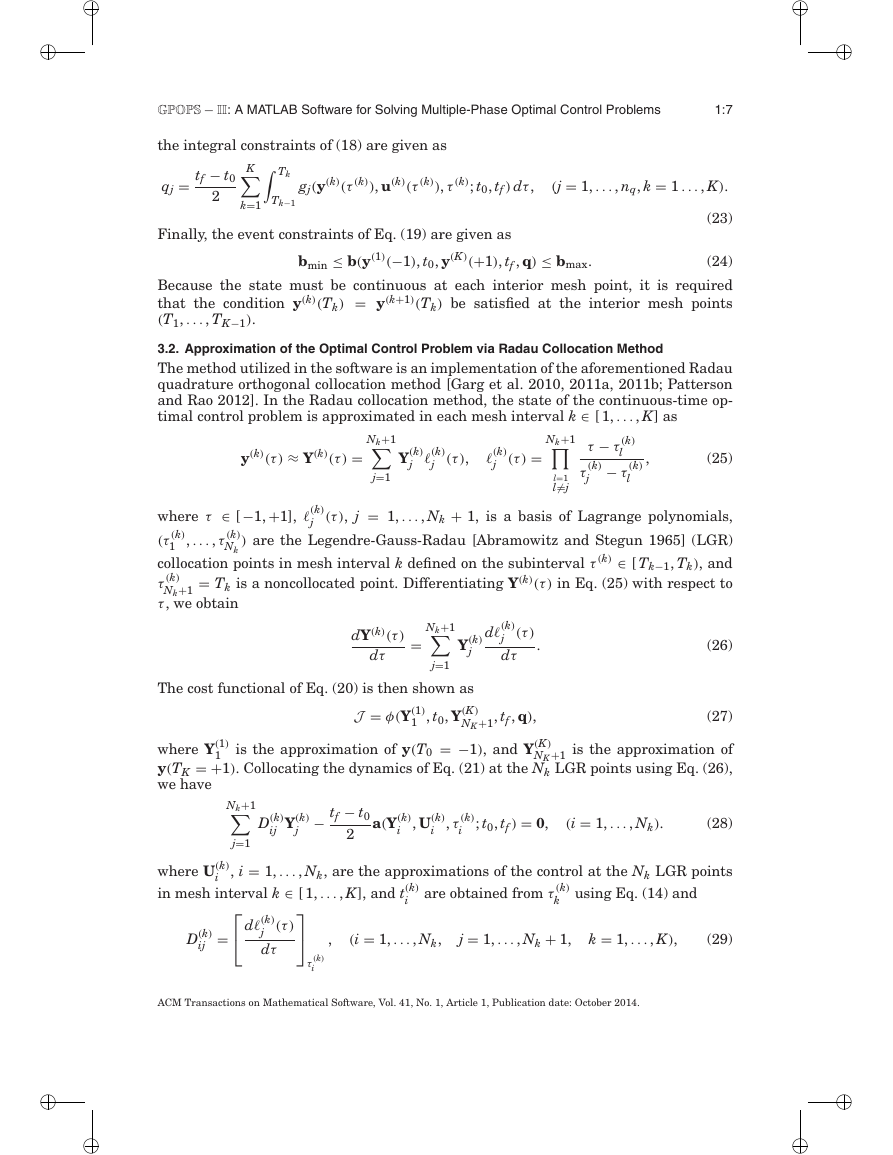









 2023年江西萍乡中考道德与法治真题及答案.doc
2023年江西萍乡中考道德与法治真题及答案.doc 2012年重庆南川中考生物真题及答案.doc
2012年重庆南川中考生物真题及答案.doc 2013年江西师范大学地理学综合及文艺理论基础考研真题.doc
2013年江西师范大学地理学综合及文艺理论基础考研真题.doc 2020年四川甘孜小升初语文真题及答案I卷.doc
2020年四川甘孜小升初语文真题及答案I卷.doc 2020年注册岩土工程师专业基础考试真题及答案.doc
2020年注册岩土工程师专业基础考试真题及答案.doc 2023-2024学年福建省厦门市九年级上学期数学月考试题及答案.doc
2023-2024学年福建省厦门市九年级上学期数学月考试题及答案.doc 2021-2022学年辽宁省沈阳市大东区九年级上学期语文期末试题及答案.doc
2021-2022学年辽宁省沈阳市大东区九年级上学期语文期末试题及答案.doc 2022-2023学年北京东城区初三第一学期物理期末试卷及答案.doc
2022-2023学年北京东城区初三第一学期物理期末试卷及答案.doc 2018上半年江西教师资格初中地理学科知识与教学能力真题及答案.doc
2018上半年江西教师资格初中地理学科知识与教学能力真题及答案.doc 2012年河北国家公务员申论考试真题及答案-省级.doc
2012年河北国家公务员申论考试真题及答案-省级.doc 2020-2021学年江苏省扬州市江都区邵樊片九年级上学期数学第一次质量检测试题及答案.doc
2020-2021学年江苏省扬州市江都区邵樊片九年级上学期数学第一次质量检测试题及答案.doc 2022下半年黑龙江教师资格证中学综合素质真题及答案.doc
2022下半年黑龙江教师资格证中学综合素质真题及答案.doc